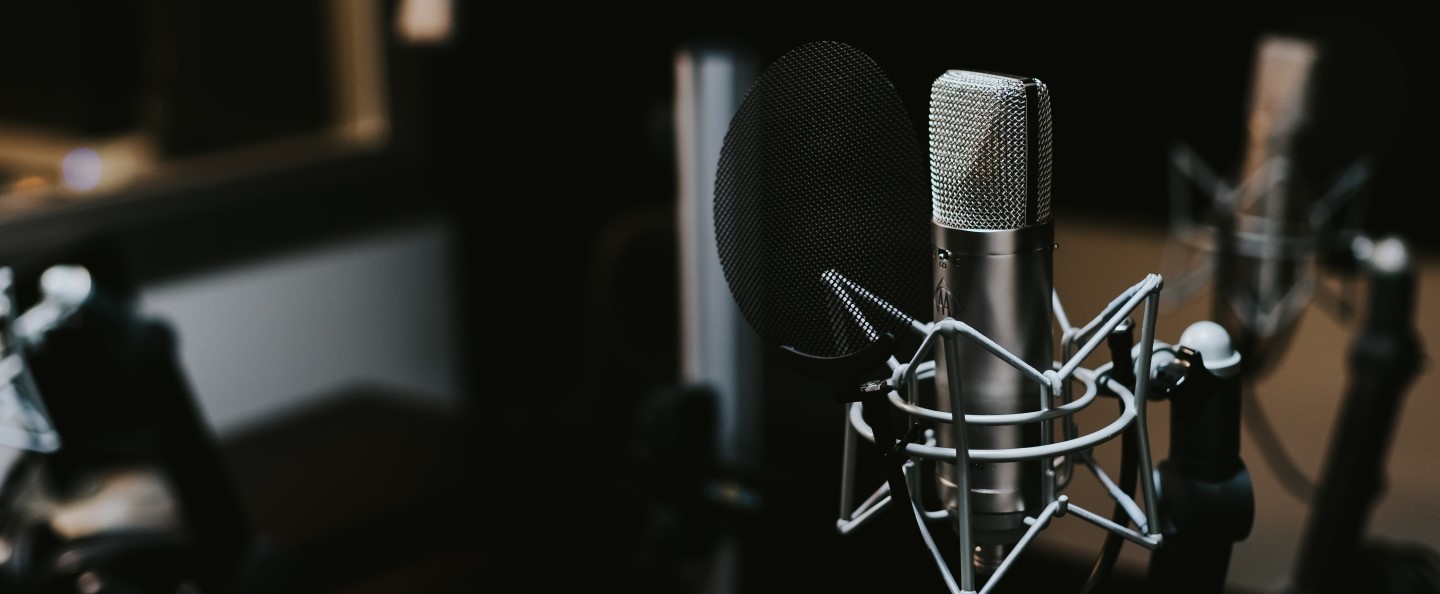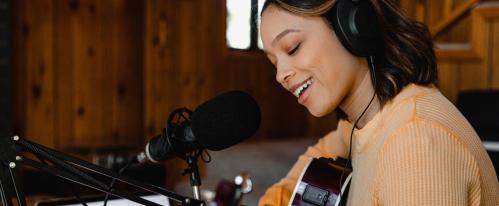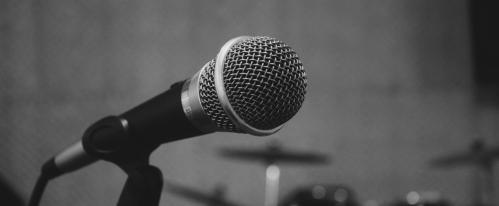We explore different microphone types and discuss the best ways to use dynamic, small condenser, large condenser, and ribbon mics in the studio and on-stage
If you’re a little overwhelmed by the selection of microphones available to you when recording or playing live - don’t worry. We’re here to teach you about the most common types of microphones that you will find both on-stage at a gig or in a recording studio setup, looking at what each type of mic is best suited for and how you should use it.
In this blog we’ll be looking at 4 different microphone types:
- Dynamic Microphones
- Large Diaphragm Condenser Mics
- Small Diaphragm Condenser Mics
- Ribbon Microphones
We’ll discuss the pros and cons of each and the kinds of applications that they’re most commonly used for.
At PMT we stock a huge range of different mics, but hopefully after reading this we can point you in the right direction and help you to find the most suitable mic for your particular needs.
You can also watch our video on How to Choose a Microphone below:
Dynamic Microphones
First up, we’re going to talk about dynamic microphones. Here we can find some of the most renowned microphones in history such as the Shure SM58 and SM57, and these are the types of microphone that you’re most likely to find in a live scenario, either at a gig or in a rehearsal room.
The reason for this is that dynamic mics are a lot tougher and less sensitive than the more fragile condenser and ribbon mics that we’ll be looking at a little later - plus they’re usually much more affordable.
The capsule of a dynamic mic works sort of like a speaker but in reverse - whereas a speaker moves back and forth to push out sound waves, a dynamic microphone has an induction coil suspended in front of a magnet which moves when it’s hit by the pressure of sound waves coming from whatever you point it at.
They’re extremely versatile, often seen as the workhorse, jack-of-all-trade microphones for both live and studio work - but they do have certain characteristics that make them particularly suited to the live environment.
Firstly, they usually feature quite a directional cardioid or supercardioid polar pickup pattern, meaning they’ll only really pick up sound from the direction that they’re pointed in. They’re also less sensitive than a condenser microphone, meaning they usually need to be placed quite close to your sound source for best results.
This means that they’re ideal for live vocals, as they’re going to pick up less bleed from louder instruments on stage. They offer lower levels of handling noise (or ‘rumble’) from vibrations going up a mic stand, and most importantly they’re much less likely to cause feedback, which is what happens when the sound coming out of the PA speakers or monitors gets back into the mic, causing an infinite loop, which results in that horrible, ear-piercing whistle.
The design of a dynamic mic also means that they naturally handle high sound pressure levels really well, so along with live vocals, these mics are also perfect for close-miking loud sound sources such as drums, guitar cabinets, and brass instruments.
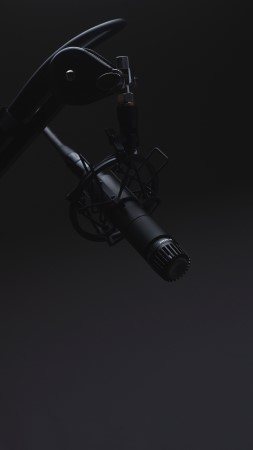
Dynamic mics are also very popular in the world of podcasting and broadcasting, with mics such as the Shure MV7 designed specifically for podcasting. For the same reasons that dynamic mics are great for live work, broadcasters love them as they pick up less background noise - so they’re great for recording interviews in noisy environments. They also offer quite a distinct tonality for speech which many people prefer.
These many different advantages of a dynamic mic however, can also be seen as disadvantages when used in a recording studio, especially when recording either vocals or instruments with a wide dynamic range. Some singers do prefer to use a dynamic mic in the studio - for example, Michael Jackson famously used a Shure SM7 to record all his vocals on Thriller - but with that being said, most vocalists recording in a studio will be using a completely different type of microphone…
Large Diaphragm Condenser Microphones
This type of microphone works in a completely different way to a dynamic mic. Large diaphragm condensers utilise a large capacitor which converts acoustic vibrations into an electrical current. This is why they are also sometimes referred to as capacitor microphones.
The result of this difference is greatly increased sensitivity, a wider frequency and dynamic range, and a smoother, more natural sounding response. This means that they pick up and reproduce a lot more of those little intimate details and nuances, especially in things like softer vocal performances. For these same reasons, they’re also often used to record instruments such as acoustic guitars or as ambient room microphones.
There are a few things that you need to consider when using a condenser mic, however. Firstly, they’re nowhere near as tough and resilient as a dynamic mic. The condenser capsule can be easily damaged if the mic gets bashed about, and because of their high sensitivity they will also pick up a lot more background noise - so you’ll usually need to use a shock cradle to reduce rumbling caused by vibrations, and a pop shield when recording speech or vocals to stop any plosives from your Ps and B’s. You’ll also probably want to turn off anything that will cause unwanted noise in your room, such as fans or air conditioners
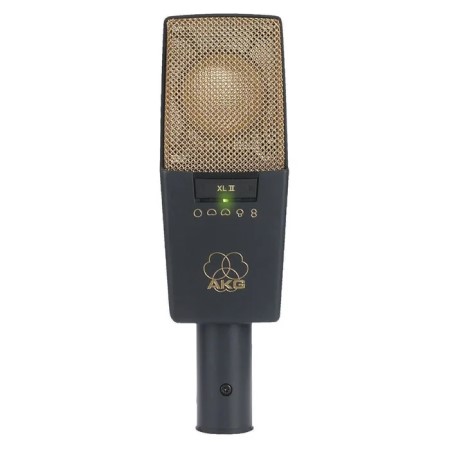
Condenser mics require a 48v power source, which isn’t too much of a problem as most mixers and audio interfaces do offer this as standard. It is something worth bearing in mind though, especially if you’re trying to figure out why your mics are not working.
Despite all of this, these types of condenser mics are still pretty versatile. A lot of them offer multiple pickup patterns such as cardioid, omni and figure 8 modes, and they’re great for recording multiple voices at the same time. Quite often on these mics you’ll find features such as pad switches to reduce their sensitivity - meaning they can still be used with louder instruments - and high-pass switches to cut the low-end frequencies.
Although condenser microphones do tend to be a little more expensive than dynamic mics, there is a huge range to choose from - starting with great value mics from the likes of Lewitt, SE Electronics, and Rode - going right up to renowned studio mics such as the AKG C414 (pictured above).
Small Diaphragm Condenser Microphones
Next up we’re looking at small diaphragm condenser microphones. These are sometimes referred to as pencil mics because they tend to look like this Lewitt Audio LCT 140.

These microphones work in the same sort of way as a large diaphragm condenser. As the name implies though, they utilise a smaller capsule, making them more compact and lighter.
Despite their smaller size, these types of mic are incredibly handy mics to have in your collection. Those smaller diaphragms actually means that they can follow the sound waves more accurately than a larger diaphragm, and they can offer an extended high-frequency response, even beyond that of human hearing.
So whilst vocalists may love the way a large diaphragm condenser mic slightly alters the tone of their voice, technically speaking, a small diaphragm condenser captures a more pure and natural sound - which is which they are commonly used to mic up orchestral instruments.
They also offer a very consistent polar pattern, and this makes them ideal for stereo miking applications. For this reason, small condenser mics are often available in pairs for use as drum overhead mics or for recording acoustic guitars.
Ribbon Microphones
The final type of mic we’re looking at today is the Ribbon microphone. Ribbon technology dates right back to the earliest days of microphones, and unlike the induction coils of dynamic mics or capacitors of condenser mics, they utilise a super-thin metal ribbon suspended between the poles of a magnet to capture those sound waves.
The result is a very dynamic and accurate sound reproduction, which tends to have a smoother high-end response when compared to condensers. This means that in addition to offering a warm, almost vintage-sounding response for vocals, they’re also great for taming harsher treble frequencies from cymbals and brass instruments, and they’re commonly used to smooth-out brittle sounds you might encounter from a guitar speaker cabinet.
Ribbon mics also offer a lower sensitivity than condenser microphones, so it’s not uncommon to see them being used in certain live situations. Their unique design also means that they naturally offer a perfect figure 8 pickup pattern, making them pretty versatile when it comes to mic placement options.
Unfortunately, all of these benefits do come with a couple of trade-offs. Firstly, a good ribbon mic doesn’t come cheap, and secondly - even though they are designed to be a little tougher nowadays when compared to older models - these are still the most fragile type of mic that we’re looking at today. Ribbon mics must be handled with particular care to prevent that ultra-thin ribbon from breaking!
One last thing.. although some ribbon mics do feature active circuitry to increase sensitivity, make sure not to accidentally send 48v phantom power to a passive ribbon mic. This can cause irreversible damage to the microphone, and as we mentioned before, these things can be quite pricey to replace or repair.
Want to learn more about the different types of microphones? Need help picking out a new microphone for recording or using live? Call us on 0151 448 2089 or check out your local store to speak to one of our Experts about your needs.

